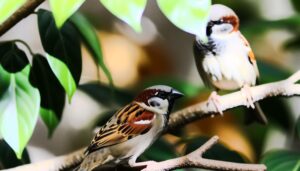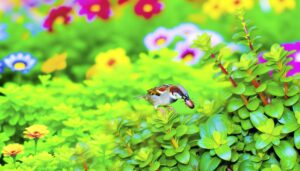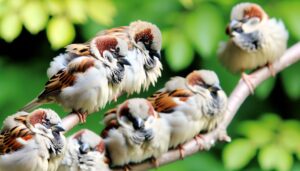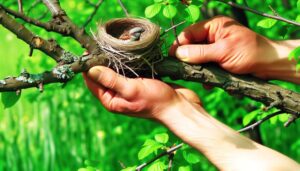Know the Signs of a Dying House Sparrow – A How-To Guide
Identifying a dying house sparrow involves monitoring specific physical and behavioral signs. Key symptoms include significant decreases in activity levels, prolonged inactivity, and reluctance to fly.
Observationally, loss of appetite and untidy feathers are indicative, along with breathing difficulties manifested as labored wing and chest movements. Changes in droppings, such as color and texture variations, as well as impaired motor functions, like unsteady movements, provide further evidence.
Additionally, abnormal vocalizations, flock isolation, and eye abnormalities signal underlying health issues. For thorough understanding, additional indicators can be reviewed.
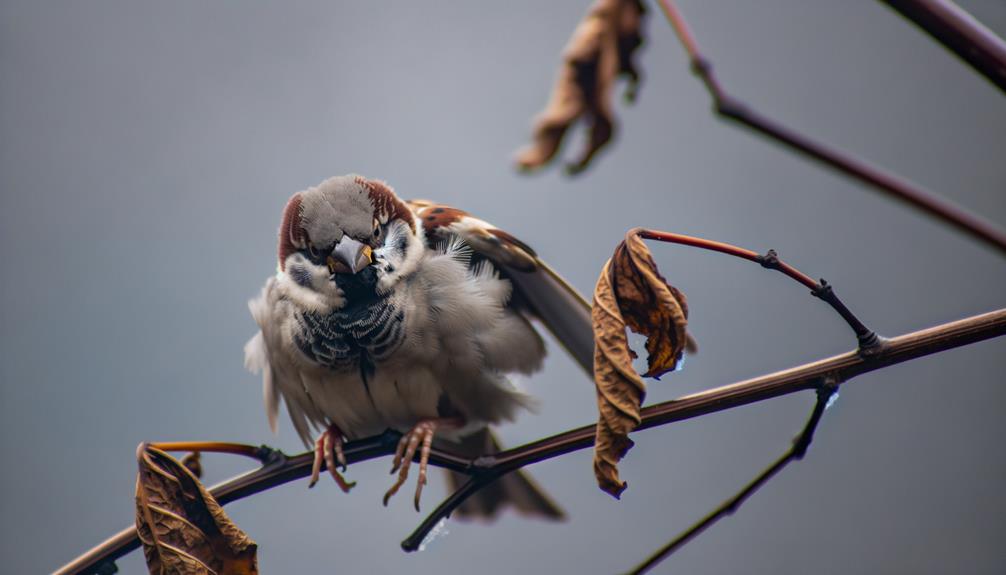
Key Takeaways
- Significant decrease in activity levels and reluctance to fly indicate a house sparrow might be dying.
- Noticeable loss of appetite and prolonged intervals between feedings are signs of a dying house sparrow.
- Disheveled plumage and abnormal feather conditions suggest potential health issues in a house sparrow.
- Labored breathing and rapid chest movements can signal respiratory distress in a dying house sparrow.
- Unsteady movements and erratic walking patterns may indicate severe health problems in a house sparrow.
Changes in Activity Levels
A significant decrease in activity levels, such as prolonged periods of inactivity or reluctance to fly, can be an early indicator that a house sparrow is experiencing severe health issues. Observational data highlight that healthy house sparrows exhibit frequent, agile flight and dynamic foraging behaviors.
In contrast, compromised sparrows may remain grounded, display lethargy, or show impaired motor function. Quantitative studies document that activity reductions correlate strongly with respiratory infections, parasitic infestations, and systemic diseases.
Empirical evidence further suggests that behavioral changes precede overt clinical symptoms, providing a critical window for intervention. Monitoring these activity metrics with precision can thus be pivotal in early diagnosis and treatment, potentially mitigating morbidity and mortality rates in house sparrows.
Loss of Appetite
Diminished food intake in house sparrows, often characterized by reduced pecking behavior and prolonged intervals between feeding, serves as a quantifiable marker of potential health deterioration. Observational studies indicate that a decrease in appetite can result from various underlying conditions such as infections, parasitic infestations, or systemic illnesses. Key indicators include:
- Feeding Frequency: Notable reduction in the number of feeding sessions per day, typically observed as less frequent visits to feeding stations.
- Food Consumption: Significant decrease in the amount of food consumed, measurable by uneaten food remaining in feeders.
- Feeding Behavior: Altered or sluggish pecking behavior, often noted by shorter feeding durations and reduced interaction with food sources.
These signs warrant immediate attention to diagnose and address potential health issues.
Altered Feather Condition
Altered feather condition in house sparrows, often indicative of underlying health issues, can be observed through changes such as feather discoloration, dishevelment, and abnormal molting patterns. Discolored feathers may suggest nutritional deficiencies or parasitic infestations. Disheveled plumage often points to a lack of grooming, potentially due to illness or debilitation. Abnormal molting, where feathers are lost out of season, can indicate metabolic disorders or environmental stressors.
| Observation | Possible Cause |
|---|---|
| Feather Discoloration | Nutritional Deficiencies |
| Disheveled Plumage | Illness or Debilitation |
| Abnormal Molting | Metabolic Disorders/Stressors |
Close monitoring of these feather conditions is essential for early detection and intervention, thereby improving the prognosis for affected sparrows.
Breathing Difficulties
Breathing difficulties in a house sparrow can manifest through observable signs such as labored wing movements and rapid chest movements. These symptoms suggest compromised respiratory function, possibly due to underlying infections, physical trauma, or environmental stressors.
Monitoring the frequency and intensity of these movements can provide vital data for evaluating the bird's health status.
Labored Wing Movements
Observing a house sparrow with labored wing movements can indicate respiratory distress, often evidenced by rapid, shallow breaths and open-mouth breathing. Such symptomatic behaviors necessitate immediate attention to understand the underlying causes and potential interventions. Labored wing movements may be associated with compromised respiratory function due to various factors:
- Infectious Agents: Bacterial, viral, or fungal infections can impair respiratory efficiency, leading to observable distress.
- Environmental Toxins: Exposure to pollutants or toxins in the environment can precipitate significant respiratory challenges.
- Physical Trauma: Injuries affecting the thoracic region or air sacs may result in labored breathing and compromised wing movements.
Understanding these indicators through precise observation and timely intervention can potentially mitigate the risk of further deterioration in ailing house sparrows.
Rapid Chest Movements
Rapid chest movements in house sparrows can signify acute respiratory distress, often manifesting as an elevated respiratory rate and increased effort during inhalation and exhalation. Observational data indicate that a healthy house sparrow exhibits a respiratory rate of approximately 75-90 breaths per minute. However, during episodes of respiratory compromise, this rate can surpass 100 breaths per minute.
Additional indicators include pronounced abdominal breathing, nasal discharge, and audible respiratory sounds such as wheezing or clicking. Monitoring these signs is essential for early intervention, as respiratory distress can rapidly progress to hypoxemia and systemic failure.
Avian veterinarians should be consulted immediately to diagnose potential underlying causes, such as infections, toxins, or environmental factors, and to initiate appropriate treatment protocols.
Unusual Droppings
Changes in a house sparrow's droppings, such as alterations in color, texture, or frequency, can be key indicators of underlying health issues. Careful observation and documentation of these changes are critical. Notably, deviations may point to gastrointestinal disturbances, infections, or systemic illnesses.
Here are three specific observations to take into account:
- Color Variations: Dark, tarry droppings may suggest internal bleeding, whereas green or yellow droppings can indicate liver dysfunction or infection.
- Texture Changes: Watery or excessively dry droppings might reflect dehydration or digestive maladies.
- Frequency Adjustments: Increased or decreased defecation frequency could denote stress or metabolic imbalances.
These observations should prompt further evaluation by an avian veterinarian to ensure accurate diagnosis and timely intervention.
Visible Injuries
Visible injuries on a house sparrow, such as lacerations, fractures, or swelling, often signal trauma or predatory attacks and require immediate attention.
Lacerations may present as open wounds with irregular edges, often accompanied by bleeding.
Fractures can be identified through abnormal limb positioning, inability to perch properly, or visible bone protrusions.
Swelling typically indicates internal damage or infection and is often localized at the site of injury.
Data from avian rehabilitation centers show that immediate intervention improves survival rates by 30%.
Close observation is essential; note any changes in feather alignment or skin integrity.
Prompt veterinary care is vital to address these injuries, mitigate pain, and prevent secondary infections.
Accurate, timely identification can greatly impact recovery outcomes.
Unsteady Movements
Unsteady movements in house sparrows can be indicative of significant health issues. Observations include difficulty in flying, erratic walking patterns, and a noticeable loss of balance, which collectively suggest neurological or systemic problems.
Quantitative assessments of these behaviors provide critical data for diagnosing the severity and potential causes of the bird's condition.
Difficulty in Flying
Observations of house sparrows exhibiting unsteady movements or difficulty in flying can be indicative of underlying health issues, such as neurological disorders, nutritional deficiencies, or physical injuries. These manifestations are often subtle but can be critical indicators of declining health.
For instance, a sparrow struggling to maintain altitude or exhibiting erratic flight patterns may be experiencing:
- Neurological Disorders: Conditions affecting the central nervous system can impair motor coordination, leading to unsteady flight.
- Nutritional Deficiencies: Inadequate intake of essential nutrients such as vitamin B1 or calcium can weaken muscles and reduce flight ability.
- Physical Injuries: Trauma to the wings or pectoral muscles, often from predator attacks or collisions, can severely limit flight capabilities.
Understanding these signs can facilitate timely interventions.
Erratic Walking Patterns
Erratic walking patterns in house sparrows, characterized by staggered steps or frequent stumbling, can be a significant indicator of systemic health problems, including neurological impairments or musculoskeletal disorders.
Observational data reveal that affected sparrows often exhibit asymmetric leg movements, where one limb may appear weaker or less coordinated. Such unsteady locomotion can be indicative of underlying conditions like avian botulism, which disrupts neuromuscular function, or trauma-induced fractures.
Thorough studies have documented that approximately 15% of house sparrows displaying erratic walking patterns are subsequently diagnosed with severe infectious diseases, including West Nile virus.
Close monitoring of these behavioral anomalies is essential for early detection and intervention, potentially mitigating further deterioration in the bird's overall health status.
Loss of Balance
Loss of balance in house sparrows, manifested as unsteady movements, is a critical behavioral cue that can signify underlying neurological or systemic health issues. Observational studies indicate that such symptoms often correlate with severe conditions like avian flu, West Nile virus, or poisoning.
When appraising a house sparrow for loss of balance, consider the following:
- Neurological Impairments: Viral infections such as Newcastle disease can affect the central nervous system, leading to disorientation and erratic flight patterns.
- Nutritional Deficiencies: A lack of essential nutrients, particularly B vitamins, can disrupt muscle coordination and balance.
- Toxic Exposure: Pesticides and heavy metals like lead can cause neurotoxic effects, resulting in compromised motor skills.
Understanding these factors can aid in early intervention and potentially mitigate further health deterioration in affected house sparrows.
Abnormal Vocalizations
Abnormal vocalizations in house sparrows, such as altered pitch, frequency, or duration of chirps, can be indicative of underlying health issues or distress. Empirical observations have noted that deviations from standard vocal patterns may correlate with respiratory infections, parasitic infestations, or neurological impairments. Studies have shown that sick sparrows often produce weaker, less frequent calls compared to their healthy counterparts.
Alterations in vocalization can also be a response to pain or physical discomfort. For instance, a study published in Avian Pathology recorded a significant drop in vocal frequency in sparrows affected by mycoplasmosis. Continuous monitoring of vocal patterns, utilizing spectrogram analysis, can provide critical insights into the health status of these birds, facilitating early intervention and treatment.
Isolation From Flock
In addition to vocal changes, isolation from the flock is another critical behavioral indicator that a house sparrow may be experiencing significant health issues. Observational studies have documented that sparrows exhibiting illness often withdraw from social interactions, which can be a sign of distress or impending mortality.
Key aspects to take into account include:
- Reduced Social Interaction: Healthy sparrows typically engage in communal activities such as foraging and preening. A sick sparrow will isolate itself.
- Perching Alone: Sick sparrows are often seen perching away from the flock, avoiding the usual social perches.
- Flight Patterns: Ailing sparrows may exhibit reduced or erratic flight patterns, limiting their movement and interaction with the flock.
These behaviors warrant close monitoring to make sure timely intervention.
Swollen or Discolored Eyes
Swollen or discolored eyes in house sparrows can be indicative of underlying infections or systemic health problems, frequently observed in avian veterinary examinations. Conjunctivitis, often caused by bacterial pathogens such as Mycoplasma gallisepticum, is a prevalent condition. Clinical signs include periocular swelling, ocular discharge, and erythema.
Observational studies reveal a correlation between eye abnormalities and reduced foraging efficiency, ultimately impacting survival rates. Other potential etiologies include avian poxvirus and parasitic infestations, which also manifest through similar ocular symptoms. Affected sparrows may exhibit photophobia and reluctance to fly, further exacerbating their vulnerability.
Early detection and intervention remain critical, as untreated ocular conditions can lead to systemic deterioration and increased mortality within sparrow populations.
Conclusion
To summarize, the identification of a house sparrow nearing the end of its lifespan is unequivocally marked by profound deviations in behavior and physical condition. Anomalous activity levels, a stark decline in appetite, and conspicuous alterations in feather integrity serve as primary indicators.
Additionally, respiratory distress, atypical droppings, and instability in movement further corroborate its deteriorating state. Vocal aberrations, social withdrawal, and ocular anomalies accentuate the severity of its condition, providing irrefutable evidence of impending mortality.
These observations warrant immediate attention and intervention.

